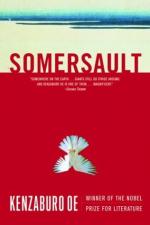|
This section contains 3,285 words (approx. 11 pages at 300 words per page) |

|
SOURCE: Wilson, Michiko Niikuni. “Kenzaburo Ōe: An Imaginative Anarchist with a Heart.” Georgia Review 49, no. 1 (spring 1993): 344-50.
In the following essay, Wilson considers the major themes in Ōe's short stories and novels, primarily focusing on Ōe's works which revolve around father-son relationships.
If there is one poem that captivated Ōe's imagination early in his career, it is “The Little Boy Lost” by William Blake. The poem projects the powerful image of a boy in quest of dialogue with his father, who has abandoned his son. The long, arduous soul-searching journey of Ōe, the Blakean “little boy lost,” began in a village in a virgin forest of Shikoku Island. This tiny village, which has become for Ōe the equivalent of García Márquez's fictional Macondo, is where the writer returns again and again to reaffirm the mythological world of what he calls the “village = nation = minicosmos.” Through the...
|
This section contains 3,285 words (approx. 11 pages at 300 words per page) |

|


